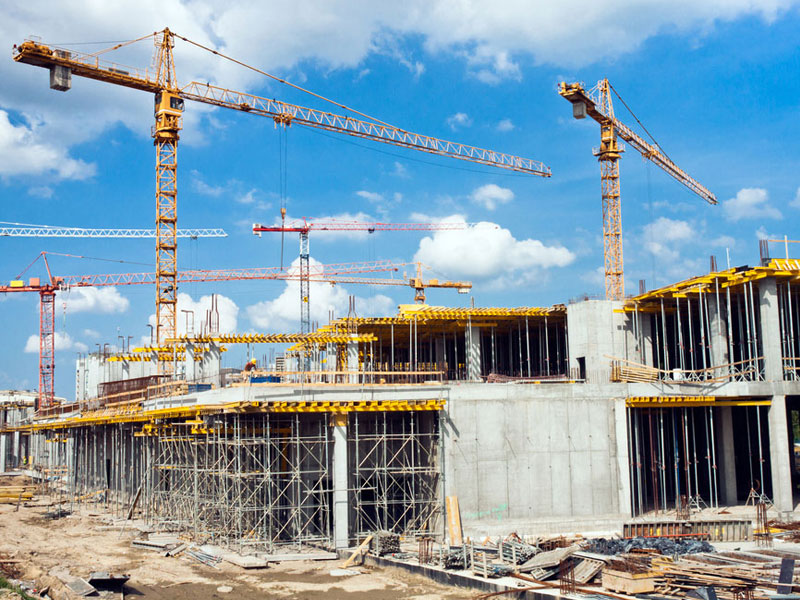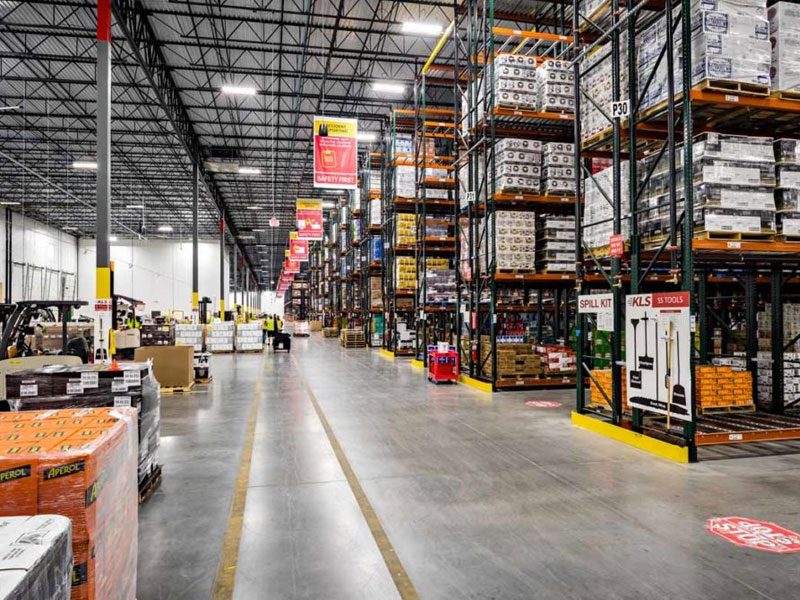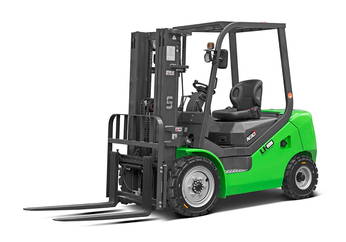Overview of Diesel Forklifts
Diesel forklifts are widely used in industrial and logistics operations due to their robust power, high load-bearing capacity, and versatility in outdoor and indoor applications. Powered by diesel engines, these forklifts can handle heavy loads and operate over uneven surfaces, making them suitable for construction sites, warehouses with outdoor access, and loading docks. Their design prioritizes lifting strength and durability, which allows operators to move large quantities of goods efficiently. However, when considering stacking multiple layers of goods or maneuvering in narrow aisles, several operational and design factors must be evaluated to ensure safety and productivity.
Stacking Capabilities of Diesel Forklifts
Diesel forklifts are capable of stacking goods to multiple levels, depending on their mast type, lifting height, and load capacity. Standard mast configurations include two-stage, three-stage, and quad-stage masts, each providing different maximum lift heights. For example, a three-stage mast can reach significant heights suitable for stacking pallets in medium to high racking systems. The lifting capacity decreases as the lifting height increases, so it is important to consider both the weight of the goods and the height at which they will be stacked. Stability and proper load balancing are critical, as stacking multiple layers increases the risk of tipping if the load is uneven or exceeds rated capacity.
Narrow Aisle Operation Considerations
Operating diesel forklifts in narrow aisles presents challenges due to their larger turning radius and weight compared to electric counterbalance or specialized narrow-aisle forklifts. While diesel forklifts can be used in moderately narrow spaces, operators must be trained to navigate tight areas safely. Adjustments such as reduced travel speed, careful steering, and precise load positioning are necessary. For warehouses with very narrow aisles, alternatives like reach trucks or turret trucks may offer more efficient maneuverability. Diesel forklifts can still be effective if aisle widths accommodate their dimensions and turning requirements, especially when stacking moderate heights rather than extreme vertical loads.
Engine Power and Load Management
The diesel engine provides high torque and continuous power output, which is advantageous when lifting multiple layers of goods or handling heavy loads. However, high engine power alone does not ensure safe stacking in narrow spaces. Load center, mast height, and counterweight design all affect the forklift’s stability. Operators must follow load charts and consider the combined weight of the goods and lifting equipment. Misjudgment in load management can result in leaning, tipping, or reduced braking efficiency. Properly balancing engine power, load placement, and operator control is essential to maintain safe operation in both narrow aisles and multi-layer stacking scenarios.
Operator Training and Safety Protocols
Operator competence is critical when using diesel forklifts for stacking or navigating confined spaces. Training should cover load assessment, proper lifting techniques, steering in narrow aisles, and emergency procedures. Awareness of the forklift’s turning radius, blind spots, and stability limits is necessary to prevent accidents. Regular practice and adherence to safety guidelines reduce the risk of collisions, load tipping, or damage to racking systems. Safety protocols may include using spotters in complex environments, ensuring floor surfaces are even, and applying speed limits for areas with high traffic or confined spaces.
Environmental Considerations
Diesel forklifts emit exhaust gases, which can impact indoor air quality, particularly in warehouses with limited ventilation. When stacking multiple layers in enclosed spaces or operating in narrow aisles, proper ventilation or exhaust extraction is necessary to maintain a safe working environment. Additionally, noise levels and engine vibrations can affect operator performance and concentration. Planning the layout and ensuring adequate airflow help mitigate these factors. In some cases, electric forklifts or hybrid options may be preferred for indoor stacking tasks to reduce emissions while still maintaining lifting capabilities.
Maintenance and Performance Factors
Regular maintenance of diesel forklifts is essential to sustain lifting performance, especially when handling multiple layers of goods. Key components such as the hydraulic system, mast, forks, tires, and brakes require inspection and servicing. Worn hydraulic seals or uneven tire pressure can affect load stability and lifting smoothness. Consistent maintenance ensures that the forklift operates within its specified capacity and reduces the risk of mechanical failure during intensive stacking operations. Maintenance records also help track performance trends and anticipate necessary component replacements before issues affect operational efficiency.
Comparison of Diesel Forklifts for Stacking and Narrow Aisle Use
| Feature | Diesel Forklift Standard Use | Considerations for Narrow Aisles / Multi-Layer Stacking |
|---|---|---|
| Lifting Height | Up to 6 meters with multi-stage mast | Stability decreases at maximum lift, load must be within rated capacity |
| Load Capacity | 1.5 to 5 tons typical | Check load charts for high stacking; uneven loads increase risk |
| Turning Radius | Moderate, suitable for open areas | Narrow aisles require careful navigation; may need spotters |
| Engine Power | High torque for heavy loads | Requires balanced load management to maintain stability |
| Emissions | Diesel exhaust present | Indoor ventilation needed; electric alternatives reduce air impact |
Operational Efficiency in Layered Stacking
Efficiency in stacking multiple layers depends on the forklift’s lifting speed, precision, and operator skill. Diesel forklifts with responsive hydraulic systems allow smooth vertical movement, reducing the risk of misalignment when placing goods on higher layers. Pallet positioning accuracy is essential to prevent uneven weight distribution, which could compromise stability. Time management is also affected by aisle width and maneuvering space. In wider aisles, diesel forklifts can stack efficiently; in narrower spaces, additional care slows operations but maintains safety. Balancing speed with precision ensures that multi-layer stacking tasks are completed reliably.
Alternative Solutions for Confined Spaces
In environments where narrow aisles limit diesel forklift operation, alternative equipment may be more effective. Reach trucks, counterbalanced electric forklifts, and articulated forklifts offer enhanced maneuverability while maintaining stacking capabilities. These alternatives can navigate tighter spaces, reducing the risk of collisions or tipping. Diesel forklifts remain valuable in hybrid scenarios where outdoor loading and high-capacity lifting are required, while narrower aisle tasks are handled by specialized equipment. Selecting the appropriate type of forklift for the operational context improves safety, productivity, and equipment lifespan.
System Layout and Planning Considerations
Warehouse or logistics system layout significantly affects the suitability of diesel forklifts for stacking and narrow aisle use. Wider aisles, reinforced flooring, and clear signage facilitate safe operation. The placement of racks and pallets should consider forklift turning radius, lifting height, and visibility. Combining layout planning with training and proper maintenance ensures that diesel forklifts operate efficiently without compromising safety. Strategic planning helps determine whether diesel forklifts alone can manage multi-layer stacking or if additional equipment is required to optimize operations.
Conclusion on Diesel Forklift Suitability
Diesel forklifts are capable of handling multiple layers of goods and performing heavy lifting in moderately narrow aisles if operational constraints are addressed. Key considerations include mast height, load capacity, operator skill, environmental conditions, and maintenance. While diesel forklifts excel in outdoor and high-capacity tasks, extremely narrow aisles may require alternative forklift types for efficiency and safety. Integrating careful planning, proper training, and equipment monitoring allows diesel forklifts to perform multi-layer stacking and narrow aisle operations effectively while maintaining operational stability and reliability.











 中文简体
中文简体 عربى
عربى Español
Español














